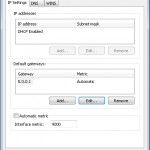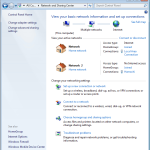Recently ran into an issue with Hamachi / Windows 7 where I couldn’t set the Network Type for the Hamachi connection.  I use Windows Firewall, and wanted to specify the Hamachi network as “Home.” However, the normal option to change network type wasn’t there in Network and Sharing Center. It just said “Unidentified Network” with blank space underneath:
It turns out, Windows 7 (and I assume Vista) will do this when there is no Default Gateway set up on the network. For Hamachi, this can be set to the same address as their DHCP server: 5.0.0.1. To avoid having to manually enter an address, this should be entered separately in the Advanced TCP / IP settings window:
That window is accessible through the “Advanced” button where you would normally set a static IP address. After that, the option was available, and the network was no longer listed as unidentified:
Just another reference post. Hope this is useful!
Sources:
http://www.tomshardware.com/forum/215-63-change-network-type
http://windows7forums.com/windows-7-networking/4416-how-change-network-type-2.html#post21820


